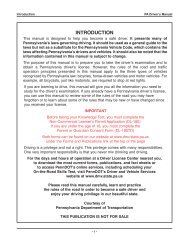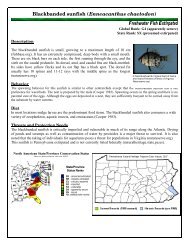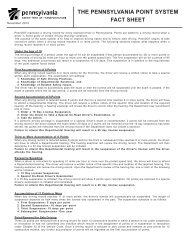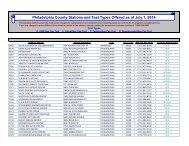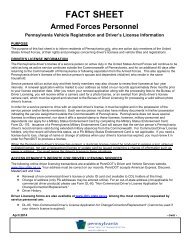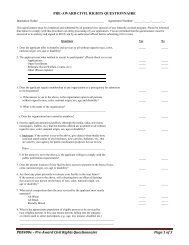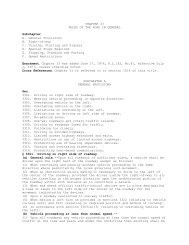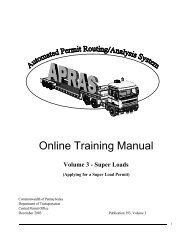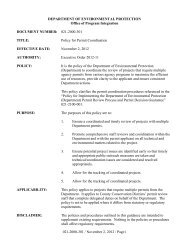fundamentals of driving a school bus - PennDOT Driver and Vehicle ...
fundamentals of driving a school bus - PennDOT Driver and Vehicle ...
fundamentals of driving a school bus - PennDOT Driver and Vehicle ...
- No tags were found...
You also want an ePaper? Increase the reach of your titles
YUMPU automatically turns print PDFs into web optimized ePapers that Google loves.
UNIT G - Fundamentals <strong>of</strong> Driving a School BusFigure G-1. Stay in LaneAIM HIGH IN STEERINGAND SMOOTH OUTCURVES, BUT ALWAYSSTAY IN YOUROWN LANE.Making Left <strong>and</strong> Right TurnsThe procedures listed below will enable you to prepare for<strong>and</strong> make turns <strong>and</strong> to reenter the traffic pattern whilemaintaining proper lane positions. When making either aleft or right turn, start signaling at least 100 feet beforeturning, if you are travelling at speeds <strong>of</strong> 35 mph or less,<strong>and</strong> at 300 feet if you are travelling at speeds over 35 mph.(See Figures G-2 <strong>and</strong> G-3.)WHETHER MAKING A RIGHT OR LEFT TURN, BEAWARE THAT THE REAR OF YOUR BUS WILL PROJECTOUTWARD AS YOU ARE MAKING THE TURN. BECAREFUL WHEN MAKING A LEFT OR RIGHT TURNWHEN YOU ARE NEXT TO ANOTHER VEHICLE OROBJECT.Keep in mind that Pennsylvania <strong>school</strong> <strong>bus</strong> crash statistics show improper turning was indicated as the thirdmost common driver action in crashes when the <strong>school</strong> <strong>bus</strong> was the prime unit. Data also indicates that 38percent <strong>of</strong> <strong>school</strong> <strong>bus</strong> prime unit crashes were angle crashes, which most commonly occur at intersections.Left Turn ProceduresLeft turns in a <strong>school</strong> <strong>bus</strong> are generally not as difficult technique-wise to make as right turns, but they are moredangerous. Left turn collisions at intersections tend to be severe crashes. Be sure you have adequate gaps inopposing traffic to make your maneuver. Acceleration rates are different in a <strong>school</strong> <strong>bus</strong> than for a passengervehicle, <strong>and</strong> you are <strong>driving</strong> a longer vehicle.1. Get into the proper lane well in advance <strong>of</strong>Figure G-2. Left Turnsthe turn.2. Give left turn signal early (at least 100 feetaway, if you are travelling at speeds <strong>of</strong> 35mph or less, <strong>and</strong> at 300 feet, if travelling atspeeds over 35 mph).3. Reduce speed <strong>and</strong> downshift to the propergear needed to execute the turn. The speedthrough the turn will depend on the geometry<strong>of</strong> the intersection as well as trafficconditions.4. Check traffic conditions to the front, rear <strong>and</strong> sides.5. Position the <strong>bus</strong> to the left edge <strong>of</strong> the traffic lane.6. Because you do not have the right-<strong>of</strong>-way (unless at a protected left turn phase at a signalizedintersection), re-check traffic signals, signs, pedestrians, or vehicles for a clear right-<strong>of</strong>-way. Use bothoutside mirrors <strong>and</strong> check especially for vehicles attempting to pass the <strong>bus</strong> on the left side.7. If you must stop before making the turn, keep the front wheels straight <strong>and</strong> the brake pedal pressed.This stopping procedure will prevent your <strong>bus</strong> from being shoved into the path <strong>of</strong> oncoming traffic, ifyou are struck from the rear. Also, leave a space <strong>of</strong> a few feet between your <strong>bus</strong> <strong>and</strong> the vehicle infront <strong>of</strong> you. You should be able to see the rear wheels <strong>of</strong> the vehicle in front <strong>of</strong> you. If not, you are tooclose.Pennsylvania School Bus <strong>Driver</strong>’s Manual • PUB 117 G-9



